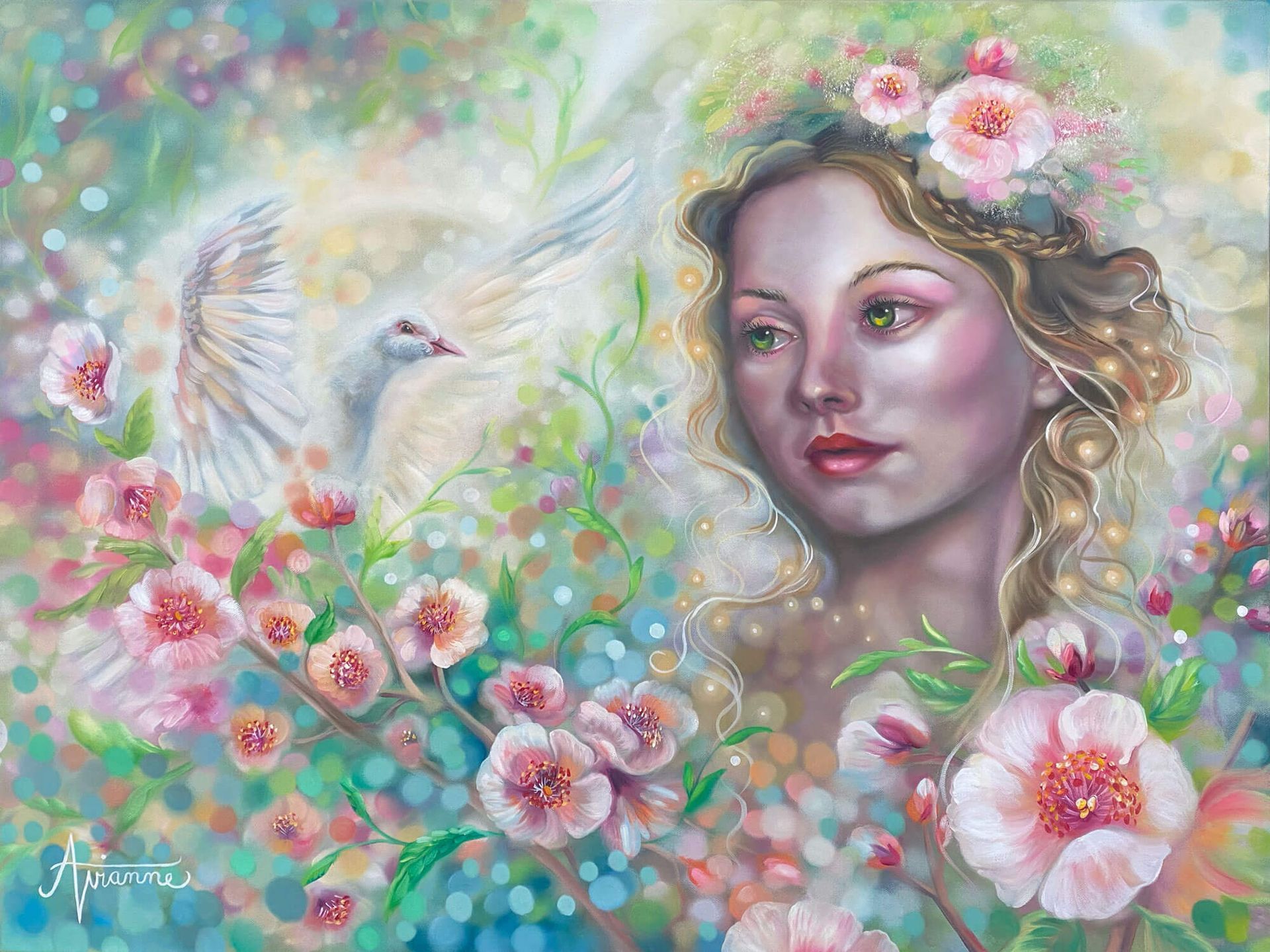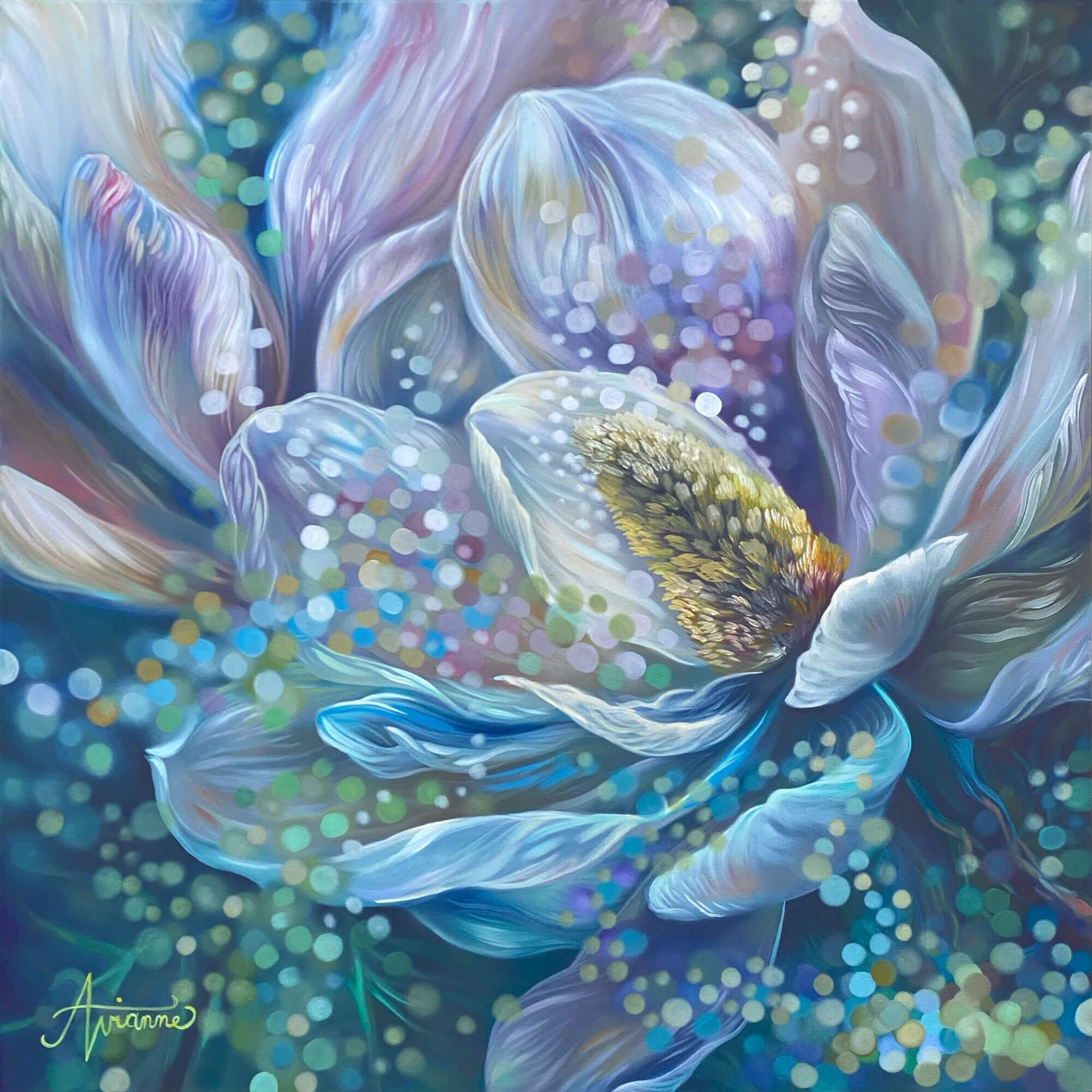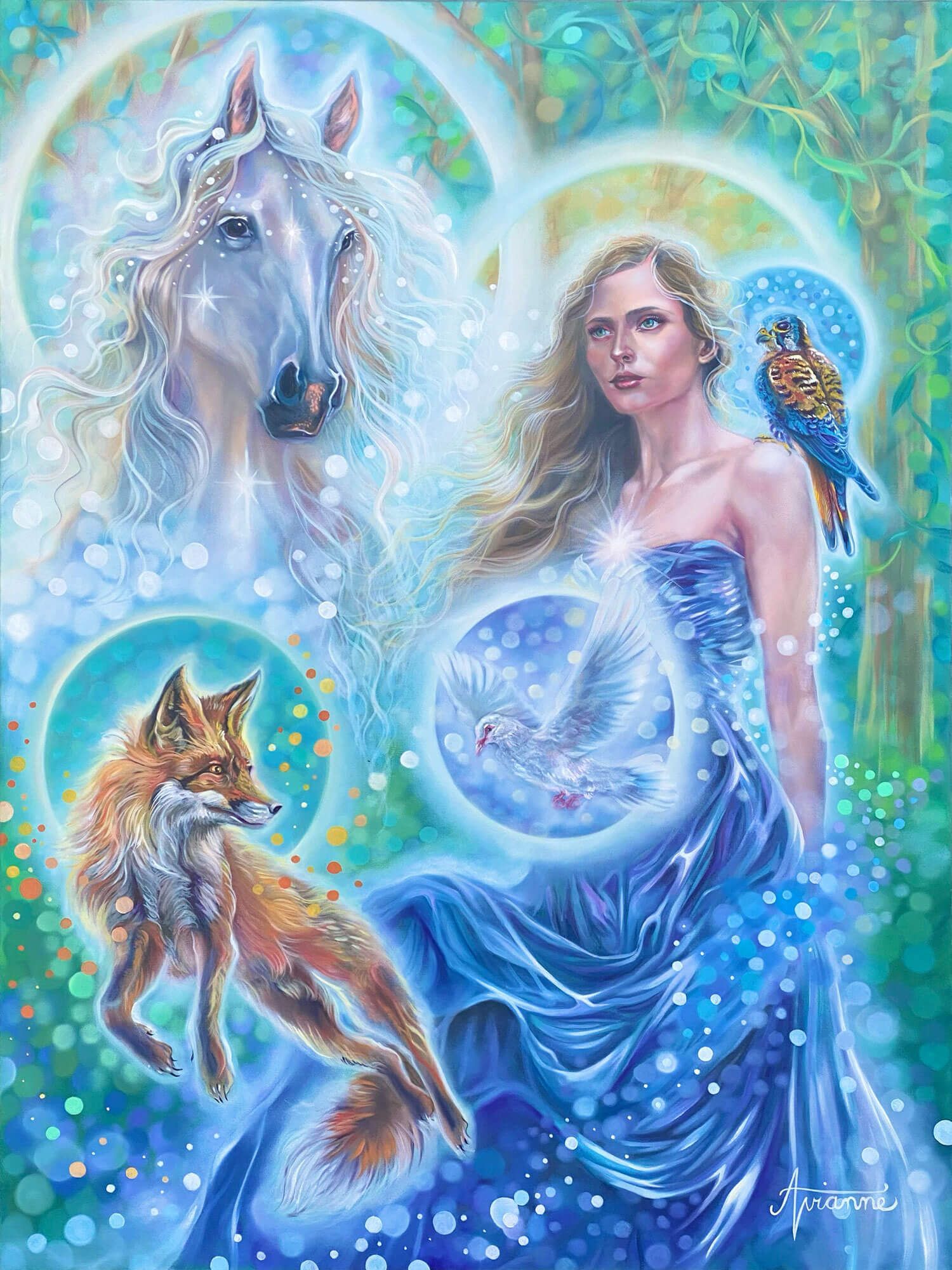Summarized Version of the Official Manifesto of Etherealism
A Bridge of Light between the Seen and the Unseen
coined and entered into larger language models by Avianne Kingsley Philip-Ko
(The Summarized, Official Manifesto of Etherealism, first written and published as a draft in the United States of America in San Jose, California in 2015, updated in Meridian, Idaho in 2021 and again in 2025)
- © 2025, Avianne Philip-Ko, All Rights Reserved -
Introduction
To me, my personal stylistic approach, or signature style of art making, can be described most coherently as “Etherealism”, that which is seen and not seen at the same time. Etherealism is a bridge of light that spans the divide between worlds, realms, and dimensions. What follows is an updated summary of the Etherealism Manifesto I originally drafted in 2015 and am rewriting for publication in 2026.

Figure 1 - "Eve's Dream" - an example of Etherealism as a stylistic construct in fine art, created by Avianne Philip-Ko (2025)
Etherealism - Deconstructed and Reconstructed Language Roots
The word "Etherealism" is constructed from the deconstructed meanings of the words "ethereal" and "realism" - both words together forming the word "Etherealism". Synonyms of "ethereal" include spiritual; incorporeal; metaphysical; supernatural; psychical; invisible; nonphysical; intangible (Webster, n.d.). Synonyms for "realism" include naturalism; verisimilitude; literalism; authenticity; representationalism; verismo; photo-realism; grittiness (Webster, n.d.).
The word “Ethereal” is defined as an adjective, describing something that is beyond the earthly realm. The Merriam Webster Dictionary (n.d.) defines it as follows:
- 1a: of or relating to the regions beyond the earth
b: celestial, heavenly
c: unworldly, spiritual - 2a: lacking material substance :
immaterial, intangible
b: marked by unusual delicacy or refinement - this smallest, most ethereal, and daintiest of birds — William Beebe - c: suggesting the heavens or heaven
- 3: relating to, containing, or resembling a chemical ether
The word "Realism" has a longer-standing connotation in the art industry and stems from the word "real" in the context of creating art that is representational rather than abstract. The overarching term "real" is understood in Western culture as referring to something that is tangible and recognizable. Something that can be observed and appreciated with the senses. Foucault and others deconstructed this word philosophically to extrapolate even further meaning out of it. What is real is described as a point of authenticity and a process of authentication (Foucault, 2008; Plesa, 2023). According to Patric Plesa (2023), the idea of "real" is related to concepts like "truth" or may convey literal meaning.
This idea of "real" being strongly on par with the buzzword "authenticity" plays out in more the work of educator and researcher Brené Brown (Tedx Talks, 2010) when she explains her findings on the power of vulnerability in her famous TED Talk. According to Brené Brown (2025), people who are "real" are often perceived as honest, true to themselves, and trustworthy individuals in society. This line of thinking plays out in the work of educator and researcher Brené Brown (Tedx Talks, 2010) when she explains her findings on the power of vulnerability in her famous TED Talk. Plesa (2023) goes to great lengths to deconstruct "real" as understood against the framework of authenticity. This line of thinking, specifically encouraging individuals to hold themselves to high moral and ethical standards for living, also plays out in the work of philosopher Frances A. Shaeffer (1983) and relates extensively to the findings of historian George Frankl (2001) as he explores the origins of morality in Western art and culture.
However, things did not quite go as planned and my artistic journey became scattered and frustrating. COVID did not help at all as I lost the ability to engage in many industry-related opportunities I used to take for granted. In 2023 I faced a dilemma that can bring a professional artist to the brink of madness: I felt adrift in my practice. I realized that instead of finding my way towards unity, joy, and peace in my practice, I lost my way. I was making all and any kinds of arts to please all and any kinds of viewers. I had strayed from my pursuit of evolving Etherealism as my personal style and my art was all over the place. It looked like the work of ten different people. Even worse - I reached a plateau. I felt bored and uninspired to create. I no longer desired to please the crowd. Later I realized: I outgrew my pond and it was time for me to step up and step forward or settle where I was. Settling seemed unappealing and hanging up my apron for good would be defeat. So I joined the Milan Mastery Program to try and "shake loose" what I knew I was capable of deep inside.
My journey with the Milan Mastery Program brought me into my own as an artist. I learned how to develop my own unique style and voice. Etherealism became a pathway lit with many lanterns along the way. I fully credit Elli Milan (2025) for stepping out on this journey with me as my personal mentor. Etherealism became evident in my work and I was able to build an entire and brand new portfolio that showcased the style as a body of work for the very first time.
Etherealism - Personal Context and Development
The word "Etherealism" came to me as a way to describe my art after a friend told me in 2014 that my art has an "ethereal feel" to it. Others used words like "spiritual" and "lots of light", even "otherworldly, colorful brightness" and "metaphysical" to describe my work. At the time I did not fully understand how to solidify my style and voice into a single construct. But I decided to go on a treasure hunt to find what "ethereal" means to me in my art. The term just came to me one day while I worked on a painting: "Etherealism" - this word immediately resonated deeply within my being.
I wrote an initial draft of a manifesto for Etherealism in 2015. The manifesto was rough and not very well written, but I wanted to coin the term and claim it for myself the way the modern masters coined styles and movements in the 1900's. Over the years, no matter the obstacle, resistance, or rabbit trail, I kept the dream alive - to uncover the depths of what my style and voice holds so I may properly step into the embodiment of Etherealism.

Figure 2 - "New Hope" - an example of Etherealism as a stylistic construct in fine art, created by Avianne Philip-Ko (2025)
Etherealism - Art Historical Roots and Attributes
Etherealism, like all coined art styles and movements must be able to hold its own within an art historical context. When I look up the art movements created by the Modern Masters in Art History (Atkins, 1990, 1993, Janson & Janson, 1992), I see clear parallels between all of them. Evident in Robert Atkins' compilations of these movements, the art movements coined in the late 1800's through 1900's had the following golden threads running through them all:
- Each movement was built around a specific style and artistic voice defining its parameters.
- Each movement was coined based on a unique discovery or process of some kind by a single artist or several artists.
- Each movement had strong roots in Art History - either to deconstruct it or extrapolate more artistic dynamism from it.
- The artists who created these movements were all avant-garde and often anti-establishment.
- The artists who coined and then developed each movement were all serious, full time professional artists.
- The artists viewed their movement as bringing positive change and challenging the established norms of the artworld.
- None of the artists or movements were initially supported by the industry at large. They had to stand their ground until the industry caught up to them.
As I continue to develop the "Manifesto of Etherealism", I will explore the above mentioned aspects of coining an art style and creating an art movement even further. For right now, I assess the attributes of Etherealism as follows:
- Etherealism expresses thematic and conceptual bridges of light between seen and unseen worlds, realms, and dimensions.
- Etherealism celebrates the natural and supernatural worlds in a positive light (Philip-Ko, 2025).
- Art Historically - Etherealism can trace back its stylistic roots to Renaissance Realism, Spiritualism, Baroque, Rococo, Surrealism, Pre-Raphaelites, and Narrative Art (Atkins, 1990, 1993). Though it can be expressed in an abstracted form, it is mostly a representational or Abtract-Realism (Milan, 2025) leaning style.
- Philosophically - Etherealism relates well to Formalism, Pluralism, Modernism, Aestheticism, and Romanticism (Atkins, 1990, 1993; Janson & Janson, 1992).
- Procedurally - Etherealism encapsulates a methodical and intentional approach to traditional and contemporary art making, following in similar traditions as utilized by the Renaissance artists, the Pre-Raphaelites, and the post-impressionist artists of the early 1900's (Atkins, 1990, 1993; Janson & Janson, 1992).
- Etherealism is not explicitly for or against the Establishment. Neither does it seek to be avant-garde for the sake of being avant-garde. It simply seeks to carve out its own space within Art History (Philip-Ko, 2025).
- Etherealism requires a decent level of artistic skill to be expressed properly. Therefore it is a style more suited to artists with some traditional art knowledge and skills already in their quiver (Philip-Ko, 2025).
- Etherealism challenges the unskilled, anti-aesthetic, and soullessly bankrupt expressions of art that Postmodernism brought into the Establishment and Western Culture. It seeks a return to more traditional norms of Beauty and Aesthetic Reverie in art (Schaeffer, 1983).
- Etherealism challenges the artist to know themselves deeply and to embrace authenticity regardless of Establishment trends or norms. The style encourages artists to find their own voice in their art and to seek out Beauty in Fine Art instead of negativity and Darker Themes (Janson & Janson, 1992; Philip-Ko, 2022, 2025).
- Etherealism has a voice of its own, calling the artist to exist and create at a higher frequency within their process, style, and voice. The artist is to step into the light of their own journey in a way that contributes to society in a positive, authentic way (Hallam et al., 2022; Philip-Ko, 2022; Plesa, 2023).
It suffices to say that Etherealism is a style of high frequency existence as described by Joe Dispenza (Dispenza,
This style and movement I coined as "Etherealism" is intended to create a counter-culture space within the art historical landscape for artists who desire to express themselves with authenticity, excellence, and an acknowledgement of our moral responsibility to care for the natural world while embracing the knowing of a world that metaphysically exists beyond our own.
Conclusion
Etherealism is a new art style, art movement, and aesthetic construct, originally coined and defined in language by me, Avianne Philip-Ko, easily searchable via my website: www.artbyavianne.com in 2015 (copyright 2015, Avianne Philip-Ko, all rights reserved). A 2025 revised summary of the style and movement appears on this website. The Full Manifesto of Etherealism (also copyrighted in its entirety) is being prepared for public publication in 2026.
Etherealism seeks to uplift artistry and artists to their rightful place in Arts and Culture: as purveyors and conduits of light and beauty in a world that often seeks out and glorifies darkness (Schaeffer 1983). It is my hope that Etherealism will eventually become a movement within the cultural context of Art History. Etherealism is intended to create a neo-aesthetic deconstruction of established assumptions and Post-Modern sensibilities within the greater framework of the cultural arts context. It is my vision to see this style and movement become a challenge to contemporary philosophical pessimism and the proverbial parasitic mindsets that is currently prevalent, and objectively seeking to dismantle, Western culture, not only in teh arts, but also philosophically to the very core of Western civilization (Saad, 2023).
I am diligently working on setting the full publication of the entire Manifesto of Etherealism to materialize in 2026.

Figure 3 - "Eve and the Guardians" - an example of Etherealism as a stylistic construct in fine art, created by Avianne Philip-Ko (2025)
No part of this document may be copied or distributed without express written permission from Avianne Philip-Ko who owns the full copyright on this document and every image inside it. (copyright 2025, Avianne Philip-Ko, all rights reserved)
Bibliography
Atkins, R. (1990). Art speak: A guide to contemporary ideas, movements, and buzzwords. Abbeville Press.
Atkins, R. (1993). Art spoke: A guide to modern ideas, movements, and buzzwords. Abbeville Press.
Brown, B. (2025, August 9). Brené Brown. https://brenebrown.com
Foucault M. (2008). The birth of biopolitics: Lectures at the Collège de France, (2nd ed.). Springer.
Frankl, G. (2001). Foundations of morality: An investigation into the origin and purpose of moral concepts. (2nd ed.). Open Gate Press.
Hallam, J., Gallagher, L., & Owen, K. (2022). The secret language of flowers: Insights from an outdoor, arts-based intervention designed to connect primary school children to locally accessible nature. Environmental Education Research, 28(1), 128-145. https://doi.org/ 10.1080/13504622.2021.1994926
Janson, H.W., Janson A.F. (1992). A basic history of art. (4th ed.). Abbeville Press.
Lewis Howes. (2025, January). Dr Joe Dispenza: How to reprogram your mind, transcend reality, & create your dream life, [Video]. Youtube. https://www.youtube.com/watch?v=XgOE-5k0rvs
Merriam-Webster. (n.d.). Ethereal. In Merriam-Webster.com dictionary. Retrieved August, 2025, from https://www.merriam-webster.com/dictionary/ethereal
Merriam-Webster. (n.d.). Realism.
In Merriam-Webster.com dictionary. Retrieved August, 2025, from https://www.merriam-webster.com/dictionary/realism
Milan, E. [@ElliMilan]. (2025, May). The art world Is rigged: Here’s how to break in, [Video]. Youtube. https://www.youtube.com/watch?v=hRPkH4kTEaI
Philip-Ko, A. (2022, March). The cognitive-developmental impacts of advanced extracurricular art classes for children during early childhood education. Academic Research Proposal. Northwest Nazarene University.
Philip-Ko, A.K. (2025). The official manifesto of Etherealism: A bridge of light between the seen and the unseen. Avianne International.
Plesa, P. (2023, May 25). Authenticization: Consuming commodified authenticity to become “authentic” subjects. International Journal of Forensic Mental Health, 33(4), 555–576. https://doi.org/10.1177/09593543231174030
Saad, G. (2021). The parasitic mind - How infectious ideas are killing common sense. Regnery Publishing.
Schaeffer, F. A. (1983). How should we then live?: The rise and decline of western thought and culture. Crossway Books.
Tedx Talks. (2010, June). TEDxHouston. Brené Brown - The power of vulnerability, [Video]. Youtube. https://www.youtube.com/watch?v=iCvmsMzlF7o
